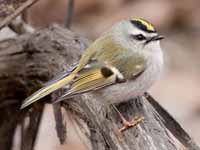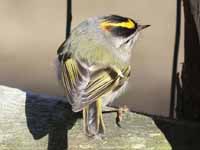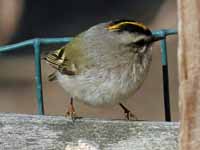Kinglets belong to the Regulidae family. The family name is derived from a Latin word meaning ruler or king. And of course the name kinglet means a little king. The males of most of the kinglet species have fancy colored crowns like a king’s crown. Plus the kinglets ARE very small: 8 to 11 cm and 6 to 8 grams. The ruby-crowned kinglet, a slight exception to the rule, does not have a fancy colored crown, but still does have usually concealed red crown patch.
The smaller the animal, the higher the heat lost per gram of body weight. Thus the very small kinglets have a high metabolism and must eat much of the time. They eat small insects which are captured via a thin bill. The insects are mainly gleaned from branches and leaves of trees, but some insects are captured in the air and some are also found on leaf litter on the ground. They tend to favor conifer forests and a couple species have a long hind claw that makes it easier to cling to a conifer branch. Since conifer tend to be northern species of trees, that implies the kinglets tend to be northern species of birds.
Probably related to their high metabolism, kinglets are relatively short lived with a maximum lifespan of 6 years. And their first year mortality is at least 75%. To make up for these statistic, the female kinglet lay a large number of eggs - 7 to 12. The nest is made out of lichen and moss, held together with spider webs. It is cup-shaped and covered, with a small entrance on the top. The nest is often suspend from a branch. It is small so the eggs must be piled on top of each other. And when the chicks hatch they pile on top of each other too. After a chick is full from eating, it burrows to bottom of the nest and the next layer takes it turn. It is advantageous for a full chick to seek the bottom as it is warmer down there.
All the family members of Reglidae have a conservation status of Least Concern.
Genus Corthylio - 1 species
Kinglet, Ruby-crowned Corthylio calendula
Description: The ruby-crowned kinglet has olive-green plumage, white wingbar with an adjacent black wingbar, and a white eye-ring. Males have a red crown patch, which is usually concealed. The sexes are identical (apart from the crown), and juveniles are similar in plumage to adults. The ruby-crowned kinglet is up to 11 cm long. The similar golden-crowned kinglet has a dark eye-stripe and no white eye-rings. The Hutton's vireo has a thicker bill and does not have a black wingbar.
Range: North America to Guatemala, Caribbean. Most breed in Canada and winter in the USA and Central America.
Habitat: Breeds in conifer forests.
Diet: Insects, spiders; also berries, tree sap.
Conservation status: Least Concern.
Image by: 1) Winnu 2, 3) Alan
D Wilson - British
Columbia 4) New Jersy Birds Range: North America to Guatemala, Caribbean. Most breed in Canada and winter in the USA and Central America.
Habitat: Breeds in conifer forests.
Diet: Insects, spiders; also berries, tree sap.
Conservation status: Least Concern.
1) Note the ruby crown

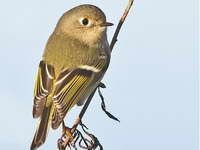
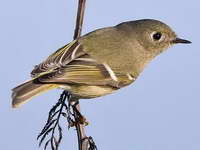
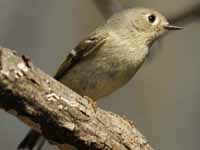
Genus Regulus
Firecrest Regulus ignicapilla
Description: The firecrest, also known as the common firecrest, has green upperparts with golden shoulders. It has two white wingbars. The male has an erectile crest that is orange in the center surrounded by yellow. The female's nonerectile crest is just yellow, not bicolored. There are bold black streaks on the crown sides and a narrow black forehead. Those black lines meet above the yellow forehead.The face is grey, and the throat plus underparts are whitish. The firecrest is 9 cm long. Firecrests and goldcrests may share the same breeding grounds, but they do not appear to interbreed.
Range: Temperate Europe, northwestern Africa, Asia Minor.
Habitat: A wide variety of woodlands, both conifers and deciduous. Also found in urban areas.
Diet: Small insects and other arthropods. They will take insects from spiderwebs.
Conservation status: Least Concern.
Image by: 1) John and Fish - Taiwan 2) Opaluna 3) Nik_Borrow - United Kingdom 4) Jose Arino - SpainRange: Temperate Europe, northwestern Africa, Asia Minor.
Habitat: A wide variety of woodlands, both conifers and deciduous. Also found in urban areas.
Diet: Small insects and other arthropods. They will take insects from spiderwebs.
Conservation status: Least Concern.
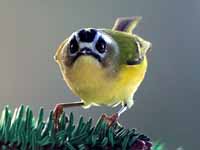
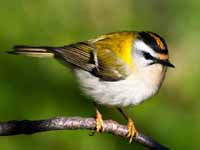
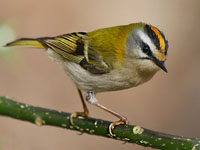

Firecrest, Madeira Regulus madeirensis
Description: The Medeira firecrest differs from its close relative the common firecreast by having what appears to be a white supercilium bisected by a black eye-line. It also differs vocally from the common firecrest by having its song divided into three distinct parts.
Range: Island of Medeira.
Habitat: A wide variety of woodlands, both conifers and deciduous. Also found in urban areas.
Diet: Small insects and other arthropods. They will take insects from spiderwebs.
Conservation status: Least Concern.
Image by: 1) Rudi B 2, 3) Andrew_MoonRange: Island of Medeira.
Habitat: A wide variety of woodlands, both conifers and deciduous. Also found in urban areas.
Diet: Small insects and other arthropods. They will take insects from spiderwebs.
Conservation status: Least Concern.
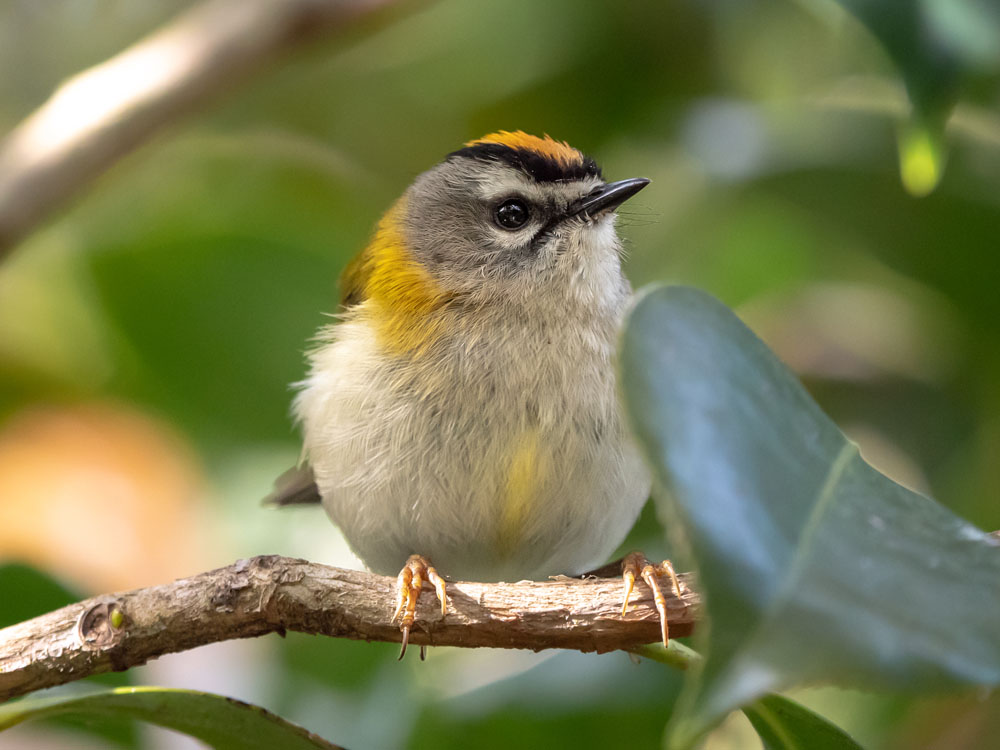
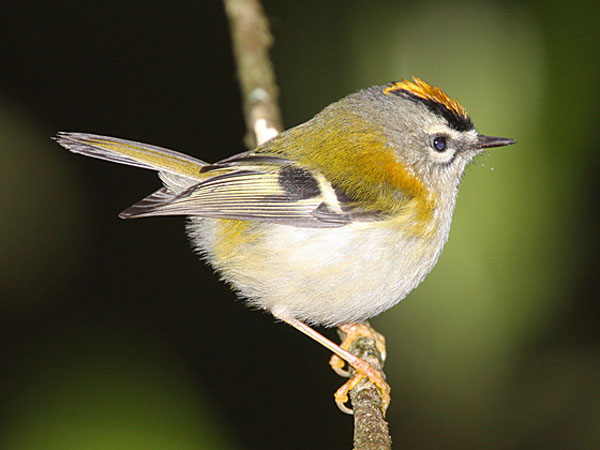

Flamecrest Regulus goodfellowi
Description: The flamecrest has yellow-green upperparts and faint white wingbars. It has a yellow rump. The male has an erectile crest that is orange in the center surrounded by yellow. The female's nonerectile crest is just yellow, not bicolored. The face is white except for a black eye-patch that is striking. It also has a white forehead and white lores. The underparts are whitish with yellow flanks. The flamecrest is 9 cm long.
Range: Taiwan.
Habitat: Evergreen forests, usually above 2000 meters.
Diet: Insects larvae, sometimes berries. Usually gleans in crown of tree, but sometimes utilizes lower vegetation.
Conservation status: Least Concern.
Image by: 1) Andrew_Eagle 2) Lin_Sun-Fong 3) mapsphotos 4) Ross TsaiRange: Taiwan.
Habitat: Evergreen forests, usually above 2000 meters.
Diet: Insects larvae, sometimes berries. Usually gleans in crown of tree, but sometimes utilizes lower vegetation.
Conservation status: Least Concern.
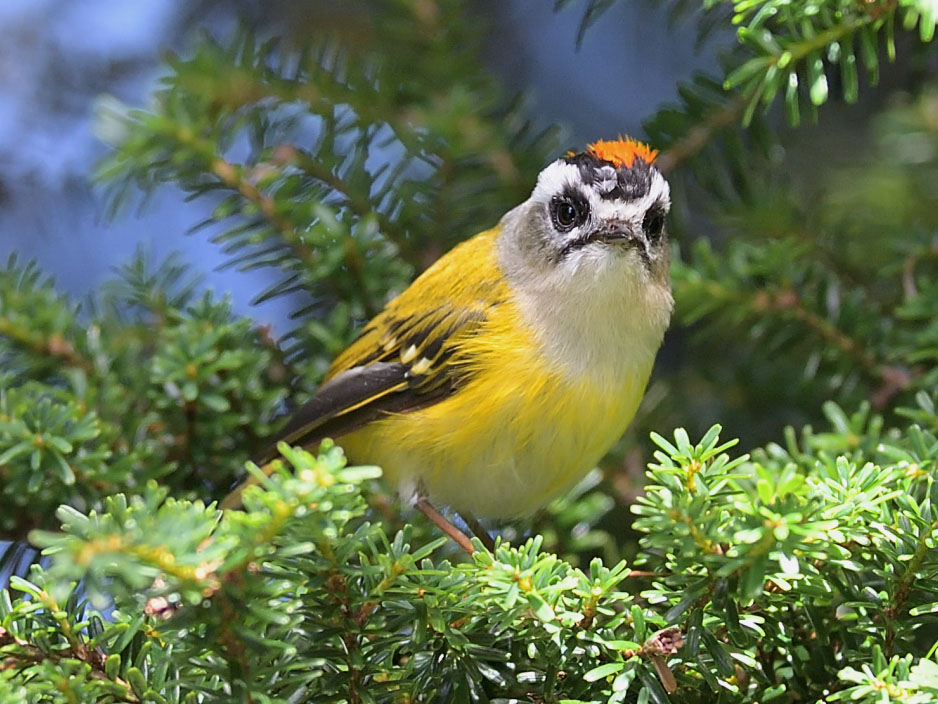


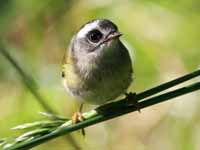
Goldcrest Regulus regulus
Description: The goldcrest has greenish upperparts. It has a white wing bar with a black patch behind it. The male has an erectile crest that is orange in the center surrounded by yellow. The female's nonerectile crest is just yellow, not bicolored. There are narrow black streaks on the crown sides and a narrow black forehead. It does not have a white supercilium. The underparts are pale grey. The goldcrest is about 9 cm long. The similar firecrest has a white supercilium and the black crown streaks are much more pronounced.
Range: Europe, Asia.
Habitat: Coniferous forsts in the breeding season, less specialized during othet seasons.
Diet: Insects, spiders, and other arthropods.
Conservation status: Least Concern.
Image by: 1) Cj Hughson 2) Oiseauxvendee - France 3) Francis_Franklin 4) Hans_Norelius - SwedenRange: Europe, Asia.
Habitat: Coniferous forsts in the breeding season, less specialized during othet seasons.
Diet: Insects, spiders, and other arthropods.
Conservation status: Least Concern.
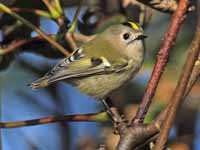
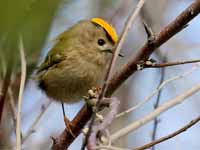
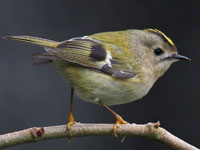
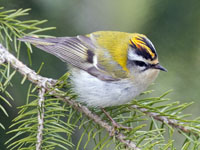
Kinglet,_Canary_Island Regulus regulus teneriffae
Description: The Canary Island kinglet is usually considered to be a subspecies of the goldcrest, but some consider it to be a separate species. Like the goldcrest, it lacks a white supercilium. However, unlike most goldcrests, the black around the yellow/orange median crown is much wider.
Range: Canary Islands of Tenerife and La Gomera.
Habitat: Mainly pine forests.
Diet: Insects, spiders, and other arthropods.
Conservation status: Least Concern.
Image by: 1) DrPhilippLehmannRange: Canary Islands of Tenerife and La Gomera.
Habitat: Mainly pine forests.
Diet: Insects, spiders, and other arthropods.
Conservation status: Least Concern.
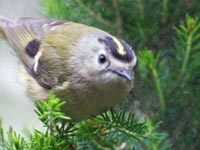
Kinglet, Golden-crowned Regulus satrapa
Description: The golden-crowned kinglet has olive-grey upperparts, white underparts, a thin black bill, short tail, white wing bars, a black stripe through the eyes, and a yellow crown surrounded by black. The adult male has an orange patch in the middle of the yellow crown. The golden-crowned kinglet is 8 to 11 cm long. The similar ruby-crowned kinglet has a white eye-ring and no black eye-line,
Range: North America.
Habitat: Coniferous forests in the breeding season, less specialized during other seasons. Most golden-crowned kinglets that breed in Canada migrate to the United States for the winter.
.
Diet: Insects, larvae, spiders.
Conservation status: Least Concern.
Image by: 1) Kelly Azar - Pennsylvania 2, 3, 4) Dick
Daniels - Scotland Neck, North Carolina Range: North America.
Habitat: Coniferous forests in the breeding season, less specialized during other seasons. Most golden-crowned kinglets that breed in Canada migrate to the United States for the winter.
.
Diet: Insects, larvae, spiders.
Conservation status: Least Concern.
